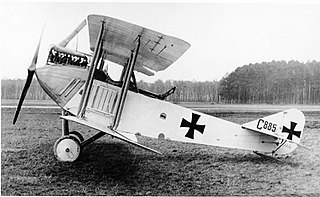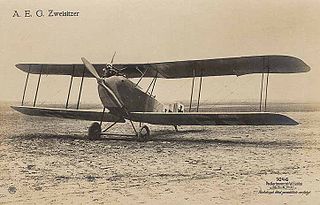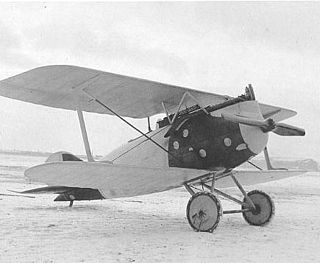
The Gotha G.V was a heavy bomber used by the Luftstreitkräfte during World War I. Designed for long-range service and built by Gothaer Waggonfabrik AG, the Gotha G.V was used principally as a night bomber.

The AEG C.II was a German two-seat biplane reconnaissance aircraft produced in small numbers from October 1915. It was a slightly smaller version of the C.I with better performance, redesigned cockpit for both pilot and observer/bombardier, new rear mounting for a 7.92 mm (.312 in) Parabellum MG14 machine gun, and the ability to carry four 10 kg (22 lb) bombs for light attack duties.

The AEG C.III was a two-seat biplane reconnaissance aircraft, a single prototype of which was built during World War I. The aircraft featured an unusual fuselage design that completely filled the gap between the upper and lower sets of wings, to provide the pilot with improved vision, and to allow the observer a wider field of fire for his 7.92 mm (.312 in) machine gun. The pilot sat to the rear of the observer, who was stationed over the upper wing. This design was not as successful as had been hoped, and the C.III was never entered into service. Despite being heavier than the C.II, its maximum speed increased to 158 km/h (98 mph).

The AEG C.IV was a German two-seat biplane reconnaissance aircraft that entered service in 1916.
The AEG DJ.I was a highly streamlined biplane ground attack aircraft of late World War I that was undergoing evaluation at the time of the Armistice.

The AEG Dr.I was a triplane fighter of World War I, based on the D.I. Only a single prototype was built and its poor performance meant that no production ensued. The Dr.I was a Dreidecker (triplane) variant of the D.I and had been inspired by a Sopwith Triplane that had been captured intact. A number of proposals for fighters with comparable characteristics were put forward, and AEG's contribution to the program appeared in October 1917. Other than the triple wing it was a D.I, the aircraft had the same fuselage, engine and twin gun armament of its earlier brethren.

The AEG G.II was a German biplane bomber aircraft of World War I developed from the AEG G.I, with more powerful engines. The G.II was typically armed with three 7.92 mm (.312 in) machine guns and 200 kg (440 lb) of bombs. The bomber suffered stability problems, and many G.IIs were fitted with additional vertical tail surfaces on each side of the fin and rudder to improve flight handling characteristics.

The AEG G.III was a German biplane bomber aircraft of World War I developed from the G.II. Like its predecessor, it was only built in small numbers and saw limited operational use, mainly far from the main fronts of the war.

The AEG G.V was a biplane bomber aircraft of World War I, a further refinement of the AEG G.IV. The type saw limited production before the Armistice, and never entered operational service. It featured a 600 kg (1,320 lb) bombload.

The Albatros C.III was a German two-seat general-purpose biplane of World War I, built by Albatros Flugzeugwerke. The C.III was a refined version of the successful Albatros C.I and was eventually produced in greater numbers than any other C-type Albatros.

Imperial German Navy seaplanes 461 and 462 were the only two examples of a seaplane design produced for the Navy's flying service during the First World War. Number 461 was built in October 1916 and Number 462 in September 1917 as the German seaplane bases searched for purpose-built training aircraft to supplement their collection of retired combat types.

The Rumpler B.I was a military reconnaissance aircraft produced in Germany during World War I.

The Rumpler D.I was a fighter-reconnaissance aircraft produced in Germany at the end of World War I. It was a conventional single-bay biplane with wings of unequal span braced by I-struts. It featured an open cockpit and a fixed, tailskid undercarriage. The upper wing was fitted with aerodynamically balanced ailerons and fuselage had an oval cross-section.

The Rumpler G.I was a bomber aircraft produced in Germany during World War I, together with refined versions known as the G.II and G.III.

The Sablatnig P.III was an airliner produced in Germany in the early 1920s.
The Sablatnig SF-1 was a reconnaissance seaplane built in Germany during the First World War.
The Sablatnig SF-2 was a reconnaissance seaplane produced in Germany during the First World War.
The Sablatnig SF-5 was a reconnaissance seaplane produced in Germany during the First World War.

The Sablatnig SF-8 was a training seaplane produced in Germany during the First World War. While Sablatnig's previous designs for the Imperial German Navy had often seen service as trainers, the SF-8 was purpose-built for this role, at Dr Sablatnig's suggestion. The SF-8 was similar to the firm's earlier designs: a conventional two-bay biplane with staggered wings of unequal span, with open cockpits in tandem.
The Halberstadt B-types of the Halberstädter Flugzeugwerke were two-seat unarmed reconnaissance/training aircraft of the German Air Force in the First World War.
















